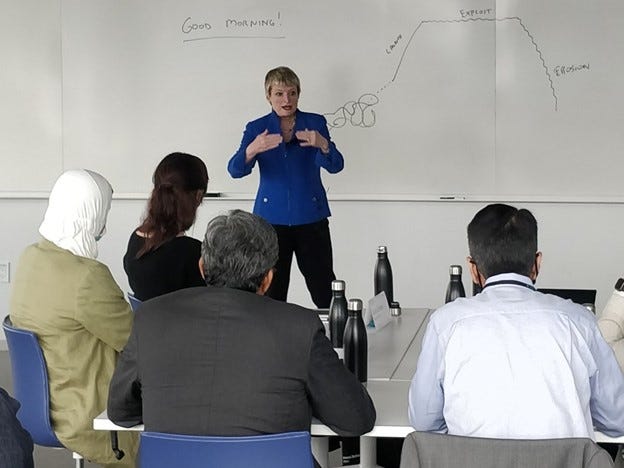Startups in distress - we've seen this movie before
May 16, 2022Wired magazine offered an article on the state of things in startup-land and discovered, astonishingly, that “The Bad times are Coming for Startups.” But not every startup, of course, mainly the ones that blithely ignore entrepreneurship 101, go for growth above all else, treat profitability as a quaint artifact from another era and haven’t figured out a sustainable business model.
In the 70’s and 80’s, mainstream business types didn’t think the idea of being an ‘entrepreneur’ was particularly sexy. Indeed, saying that you were ‘self employed’ was sometimes read as an indication that you weren’t good enough to find a “real” job, wearing a grey flannel suit in an equally grey company somewhere.
Entrepreneurs go from crazy to ….cool?
That really began to change as the first wave of Silicon Valley spawned companies started to enjoy remarkable success. Microsoft (founded 1975) and Apple (founded 1976) taught the world that computers could be useful for ordinary people, while other entrepreneurial types were amassing fortunes. A later documentary about all this was literally called, “Triumph of the Nerds.”
My colleague and co-author Ian MacMillan (Mac) started the first “real” research journal in management to focus on entrepreneurship, the Journal of Business Venturing in 1985 (for a look at his impact on the field of entrepreneurship, check out this biography or just watch the video overview). Ronald Reagan endorsed it, thus thrusting entrepreneurship into mainstream thinking as a respectable academic pursuit.
One of the things both Mac and I believed was that you don’t learn very much by studying the spectacular success of an entrepreneur’s first business. They might have just been at the right place, at the right time! And you can’t replicate luck.
Indeed, Jennifer Starr and Bill Bygrave, two early scholars working in the field, wrote a paper that didn’t get nearly enough attention in my view, finding that “second time around” entrepreneurs went after the next set of opportunities with huge liabilities from their initial success. They spent way too much money on as-yet unproven ideas. Flush with their recent success, they didn’t think they needed to test ideas with customers. They tended to hire people they’d worked with before, only this time those people were a lot more expensive and also unlikely to challenge the founders’ perspectives. In other words, they learned exactly the wrong lessons from their early remarkable successes.
Instead, what Jennifer, Mac and I got interested in was how a group he called “habitual” entrepreneurs operated. These were people who had started many businesses, some successful, some perhaps not, but rather than the bolt-of-lightning strikes perspective on entrepreneurship, we observed that they treated starting things up like a job, with common practices and approaches across their many new companies. Mac and I later wrote a book about this concept for corporations, suggesting that as competitive advantages became shorter, corporations too needed to learn to incubate and grow businesses themselves, the same way habitual entrepreneurs did. For a great blast from the past on that book, have a look at this summary from 2000, the year it came out.
The discoveries we made about multiple-venture founders were a little counter-intuitive at the time. For instance, business plans that featured lots of adjectives (“cutting edge” “one of a kind” “breakthrough”) got less funding and did less well than plans that featured either verbs (“tested” “agreed”) or nouns (“patent” “license” “prototype”). Venture capitalists preferred “B” ideas with “A” teams than the other way around. The founders themselves operated with parsimony. As Amazon famously did, they used discarded doors for desks. They spent as little as possible for as long as possible. They kept fixed costs down and only allowed variable costs to grow as the growth of the business justified it. Cash was king, so you needed to do daily, weekly, and monthly break-evens to make sure you were covering the bills.
In fact, Mac (and his co-author Zenas Block) coined a little rubric about this type of behavior:
Don’t buy what you can lease.
Don’t lease what you can borrow.
Don’t borrow what you can beg.
Don’t beg what you can…um…salvage.
The idea was to build, either with investor capital or not, a business that could perform well on its fundamentals as it went through the startup period.
The unrewarding role of teaching principles of entrepreneurship during bubbly periods.
So we thought we’d kind of cracked the code on how smart, successful, multiple-venture leaders operated. And then came the dot com frenzy.
Fueled by a desire to not miss out on the Next Big Thing since the personal computer revolution, resources went pouring into startups. Anything with a .com on its name could raise capital it seemed. My own students (I was at Columbia Business School by then) listened to me talking about the importance of parsimony and more or less giggled.
They gave up plans to go into consulting. They gave up plans to go into finance. The world of opportunity represented by the Internet was boundless, capital was freely available, and all you had to do was go for it! Or so it was for a while – a few years in fact.
As Brian McCullough later wrote, specifically about Priceline, but it could have been about a good many of the early Internet darlings, they shared the following characteristics: “a business plan that promised to “change the world”; a Get Big Fast strategy to reach ubiquity and corner a particular market; a tendency to sell products at a loss in order to gain that market share; a willingness to spend lavishly on branding and advertising to raise awareness; and a sky-high stock market valuation that was divorced from any sort of profitability or rationality.” Does any of this sound familiar (looking at you, WeWork)?
In another parallel to today’s markets, McCullough noted that “The dot-com bubble was a fantasy period when a lot of VCs actually didn’t care if a business turned a profit, because it didn’t need to. “We’re in an environment where the company doesn’t have to be successful for us to make money,” a venture capitalist at Benchmark admitted when mulling over a pre-IPO investment in Priceline.”
I’m telling you, it was painful to be talking about building a nice, steady, sustainable business when everybody wanted to cash in on the riches of a spectacular IPO.
B2C – Back to Consulting, B2B – Back to Banking
This of course is a story without suspense. A cascade of events eventually let to what came to be called the dot com crash. The Fed raised interest rates several times. Wall Street analysts began warning their clients about being overweight in tech stocks. And people began doing the math on companies with impossibly high valuations, given their revenues (let alone profits).
An article reviewing the situation from November of 2000 declared that this was no ordinary correction – it was a full blown crash, according to famed venture capitalist and investor Fred Wilson.
I remember it being deeply humbling for people who were drawn to work for these companies. One week, you’re a master of the universe who only has to say “I have a dot com idea” before someone starts throwing money at you. The next week, you’re laid off. The week after you find that you are toxic to “real” companies who never did much like the tone of all those Internet upstarts anyway.
As for our students? The standing joke was that rather than creating disruptive new companies, the new mantra was B2C – back to consulting, or B2B, back to banking.
So what does any of this teach us about today’s frothy businesses?
As people wiser than I have said, if something is not sustainable, it won’t last forever. We’ve got the Fed raising rates. We’ve got people starting to ask uncomfortable questions about the Unicorn club, unflatteringly describing Uber, for instance, as little more than a Ponzi scheme. Companies like Robinhood (home? Bored? Play the stock market as though it were a video game!) and Peloton (home? Not getting enough activity? Just climb on board) which enjoyed strong demand during the pandemic are downsizing and laying people off. Company leaders are starting to realize that it is super hard to meet payroll without cash on hand.
Cash? How 1950’s… but the lesson had to be learned before. Apparently it has to be learned again now. Matt Turck, a partner at Venture Capital firm Firstmart told Wired, “Right now, the startups that are in the trickiest situation are growth-stage startups with unicorn-type valuations, a high burn rate, good but not great metrics, and 12 months of cash. You’re going to see a lot of layoffs there, because companies need to urgently cut their burn if they don’t want to run out of cash.”
So expect the mood to be darker, the questions to be more pointed, and the belief in growth at all costs to be questioned. And maybe, just maybe, we’ll be on the road back to entrepreneurship 101.
Any bright spots?
Absolutely! As Carlota Perez has observed, bubbles and their aftermaths are a feature of how capitalism works, not a bug. Just as the railroad bubble and bust left both the US and the UK with important railroad infrastructure and the dot com bust left us with the basis for the digital businesses to follow, this bust will leave us with important infrastructure, too. The development of new kinds of software, the invention of big data solutions and many other developments are likely to be part of the foundation of the next chapter. If we are smart about what we do with it, it can well be the beginning of a new “golden age.”
Leading Strategic Growth and Change
Speaking of big companies behaving entrepreneurially, this week is all about my in-person Columbia course “Leading Strategic Growth and Change.” We explore the topic of how companies can make adaptive change a reality in a consistent way over the course of the five day program. It runs again next October.
I’m telling you, the return to in-person has us all trying to remember how we did it before. Our program manager asked me this morning, “well, what do you normally do for this part of the program?” I had to remember; I haven’t ‘normally’ done anything for two years! Humbling.
That being said, it is great to be back in person.
SparcHub
We’re also on the brink of releasing a commercial version of our SparcHub software, which helps you to bring the principles of discovery driven growth to life in an easy to manage package. You can watch a recorded demo here: https://my.demio.com/ref/ClKpAsUWzDQYdVnJ
Get in Touch, Keep in Touch!
You can follow me on Twitter (@rgmcgrath), on Instagram (@ritamcgrathofficial), on LinkedIn and on YouTube. For access to the archives, ability to make comments and read longer versions of my regular communications, subscribe.



